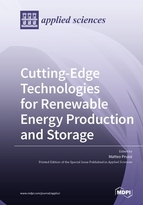Cutting-Edge Technologies for Renewable Energy Production and Storage
A special issue of Applied Sciences (ISSN 2076-3417). This special issue belongs to the section "Environmental Sciences".
Deadline for manuscript submissions: closed (15 August 2019) | Viewed by 29836
Special Issue Editor
Interests: energy conversion technologies; system analysis (climate change); net energy efficiency of bioenergy systems; life cycle assessment; bioenergy and biofuels; assessment of sustainability; socio-economic impacts of energy systems; transport policies
Special Issues, Collections and Topics in MDPI journals
Special Issue Information
Dear Colleagues,
We are very pleased to introduce this Special Issue of the journal Applied Sciences on “Cutting-Edge Technologies for Renewable Energy Production and Storage”.
The world is trying to reduce anthropogenic greenhouse gas emissions by fostering renewable energy production. The technologies for electricity production from wind and sun are well-established and are now trying to address issues of grid connection and storage due to their fluctuating nature. Energy storage is a key topic for the further deployment of renewable energy production, and, therefore, a large research effort is being made to find innovative solutions. Besides battery and other types of electrical storage, electrofuels and bio-electricity may offer suitable alternatives in some specific scenarios. E-fuels are currently being studied for their potential to supply sectors which are strongly dependent on liquid fuels, such as aviation. At the present stage of their development, technical and costs issues are burdens for their application to large-scale infrastructures. In spite of these present challenges, the further development of cutting-edge technologies is one of the pillars for directing the world on the path of a low-carbon future.
This Special Issue is looking for contributions on the following topics: cutting-edge energy conversion technologies and energy storage, technologies integration, e-fuels, pilot and large-scale applications.
MDPI and the editors of Applied Sciences are delighted to have the privilege of publishing this Special Issue. We wish to thank all the authors that will consider contributing to this Special Issue
Dr. Matteo Prussi
Guest Editor
Manuscript Submission Information
Manuscripts should be submitted online at www.mdpi.com by registering and logging in to this website. Once you are registered, click here to go to the submission form. Manuscripts can be submitted until the deadline. All submissions that pass pre-check are peer-reviewed. Accepted papers will be published continuously in the journal (as soon as accepted) and will be listed together on the special issue website. Research articles, review articles as well as short communications are invited. For planned papers, a title and short abstract (about 100 words) can be sent to the Editorial Office for announcement on this website.
Submitted manuscripts should not have been published previously, nor be under consideration for publication elsewhere (except conference proceedings papers). All manuscripts are thoroughly refereed through a single-blind peer-review process. A guide for authors and other relevant information for submission of manuscripts is available on the Instructions for Authors page. Applied Sciences is an international peer-reviewed open access semimonthly journal published by MDPI.
Please visit the Instructions for Authors page before submitting a manuscript. The Article Processing Charge (APC) for publication in this open access journal is 2400 CHF (Swiss Francs). Submitted papers should be well formatted and use good English. Authors may use MDPI's English editing service prior to publication or during author revisions.
Keywords
- Energy conversion
- Energy storage
- Technologies integration
- E-fuel
- Renewable energies
- Pilot plants






